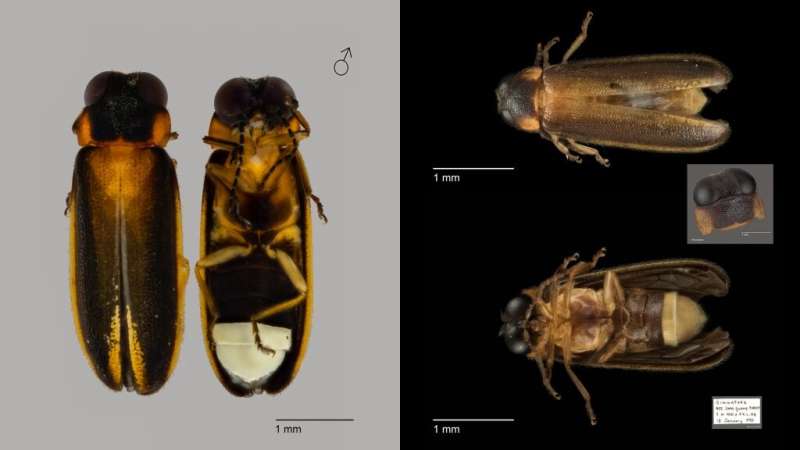New species of firefly discovered in Singapore

Researchers from the Lee Kong Chian Natural History Museum, National University of Singapore, have discovered a new species of firefly from the last remaining freshwater swamp forest in Singapore. This is the first time since 1909 that a new species of luminous firefly has been discovered in Singapore—highlighting the need for continued biodiversity research, even in small, well-studied, and highly developed countries such as Singapore.
Fireflies are one of earth's most charismatic insects, owing to their ability to produce spectacular bioluminescent displays. They are an extremely diverse group of beetles in the family Lampyridae, with more than 2000 species worldwide. It continues to fascinate many that in Singapore, a small, highly urbanized, and bustling city-state in Southeast Asia, fireflies have a scattered distribution but are not as uncommon as many would assume.
A Familiar Unknown
In 2009, a nationwide survey of fireflies by National Parks Board (NParks) at 14 sites across Singapore documented 11 firefly species, including an unidentified species, codenamed Luciola sp. 2 after the firefly genus Luciola.
"When we first encountered this species, we knew it was interesting because the specimens were collected from a freshwater swamp forest in the central catchment area of Singapore—fireflies are rarely reported from this type of habitat. Furthermore, it did not fit the descriptions of any known firefly species to-date," says Dr. Wan Faridah Akmal Jusoh, the lead author and Research Fellow at the Lee Kong Chian Natural History Museum (LKCNHM), National University of Singapore (NUS).
"We thought the specimens collected in 2009 were the only ones of the unidentified species until I started examining the firefly collection in LKCNHM and found three additional specimens collected 20 years prior. I immediately contacted my colleagues at NParks and we arranged a series of night surveys."

A 10-Year Reunion
Ten years after the 2009 nationwide survey, the researchers from NUS and NParks revisited the firefly habitat located in the Nee Soon Swamp Forest—the last remaining freshwater swamp forest in Singapore and successfully collected additional specimens of Luciola sp. 2.
However, the study did not come without its challenges. The genus Luciola contains at least 280 species, most of which cannot be readily distinguished from one another using traditional external features. Therefore, to determine the identity of Luciola sp. 2, the researchers performed intricate dissections to examine internal organs and employed modern DNA techniques through a method called genome skimming.
After two years of data collection and analysis, in collaboration with researchers from Charles Sturt University, Australia and Forest Research Institute Malaysia (FRIM) and NUS Department of Biological Sciences, the results showed that Luciola sp. 2 was both genetically and morphologically unique and was thus described as a new species called Luciola singapura.
"This study underscores the importance and utility of molecular methods that can provide solutions to problems that are otherwise difficult to resolve using traditional approaches," explains Dr. Chan Kin Onn, co-author and Museum Officer at LKCNHM.
Beacon of Hope
The last luminous firefly described from Singapore was Pteroptyx bearni Olivier in 1909, which is a well-known congregating firefly species in Southeast Asian mangroves (see page 228 our Voyageurs, Explorateurs et Scientifiques e-book). Unfortunately, this species has not been sighted in Singapore since then and is assumed to be extirpated.
This new discovery that came 100 years later gives hope that continued research in the field and among museum collections, as well as advancement in molecular techniques can help us better understand our natural heritage.
Lim Liang Jim, Group Director of the National Biodiversity Centre at NParks added: "The discovery of this new species is very significant to science in Singapore, and shows the importance of conserving the last freshwater swamp forest here. As part of efforts to transform Singapore into a City in Nature, under the NParks Nature Conservation Masterplan, we are implementing species recovery plans for our endangered and rare species which include enhancing core habitats. We currently have a species recovery plan for Singapore fireflies and this new discovery will also contribute to the understanding of the species and ecology of fireflies in Singapore."
More information: Wan F. A. Jusoh et al. Molecular Systematics of the Firefly Genus Luciola (Coleoptera: Lampyridae: Luciolinae) with the Description of a New Species from Singapore, Animals (2021). DOI: 10.3390/ani11030687
Provided by Lee Kong Chian Natural History Museum





















